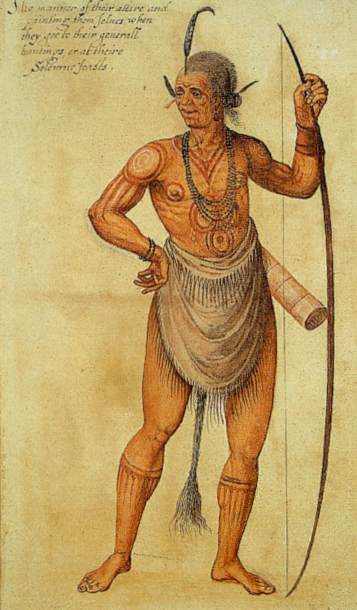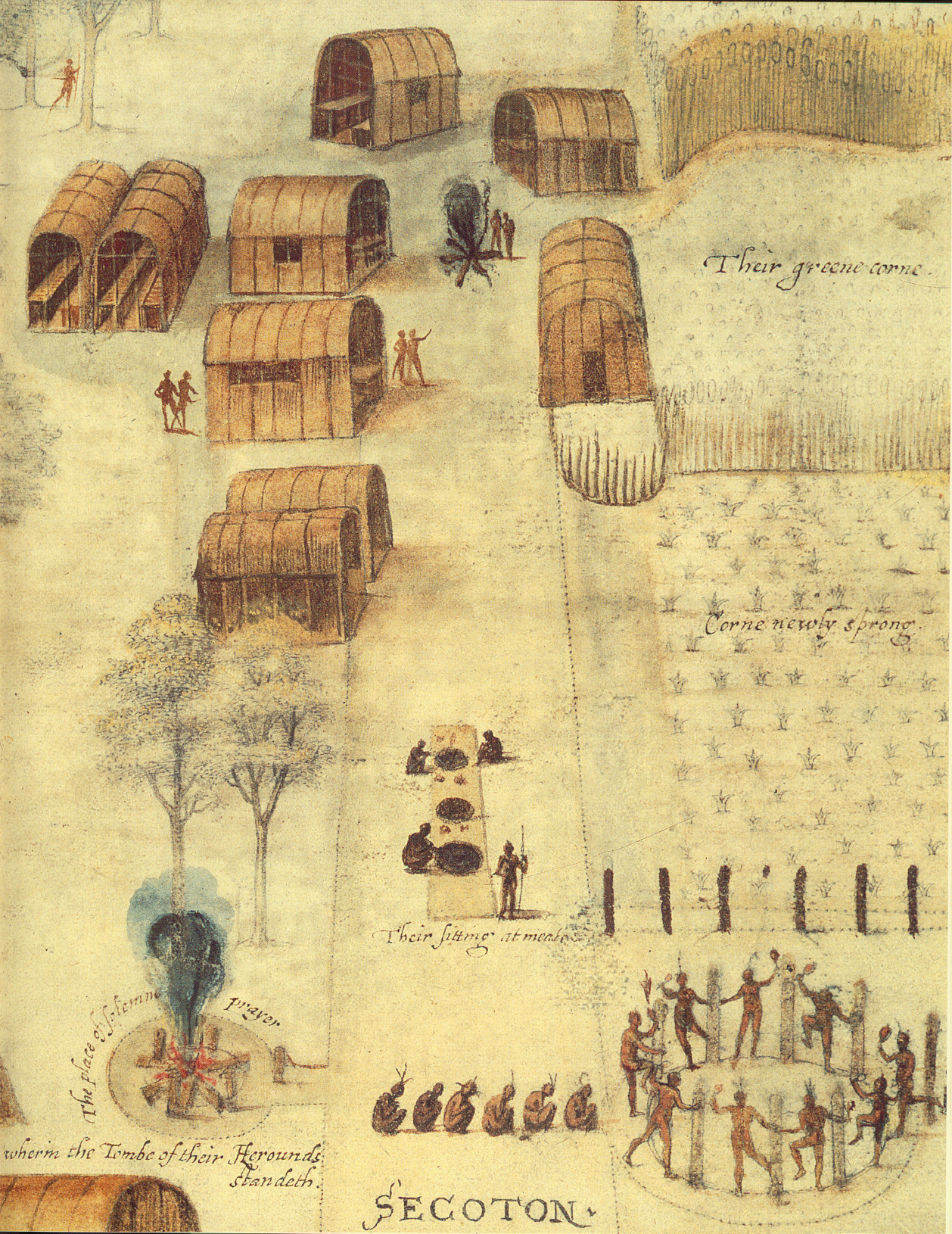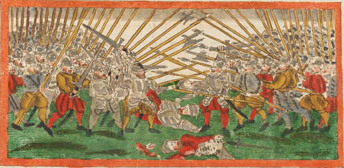|
Wingina
Wingina ( – 1 June 1586), also known as Pemisapan, was a Secotan weroance who was the first Native American leader to be encountered by English colonists in North America. During the late 16th century, English explorers Philip Amadas and Arthur Barlowe explored the region inhabited by Wingina, detailing conflicts between Wingina's tribe, the Secotan and a rival tribe known as the Neusiok. When English colonization of the region began, relations between the colonists and the Secotan quickly broke down. On 1 June 1586, in an effort to gain more stocks of food for the fledgling colony, Sir Ralph Lane led an unprovoked attack on the Secotan; Wingina was decapitated during the attack by one of Lane's men. Life Before the first English settlement on Roanoke Island, Philip Amadas and Arthur Barlowe explored the area (April 27, 1584) on behalf of Raleigh, who had received an English charter to establish a colony a month earlier. During their expedition, Barlowe took detailed notes ... [...More Info...] [...Related Items...] OR: [Wikipedia] [Google] [Baidu] |
Wingina, Virginia
Wingina is an unincorporated community in Nelson County, Virginia, United States. History This area was originally inhabited by Monacan Indians. The Monacan tribe and their allies, the Mannahoac, had settled central Virginia from the Rappahannock River to the James River for at least 500 years before the English arrived in Virginia. As the English encroached farther west into what is now central Virginia, the Indians dispersed to the north, south, and west. In the 19th century a number of Monacans created a settlement at Bear Mountain in Amherst County, where many of the tribe live today. The Saponi and Tutelo Indians are also remnants of this main confederacy. This village located on the banks of the James River between Buckingham and Nelson counties was part of the original land grant of Dr. William Cabell in 1735. Dr. Cabell received the grant of 25,000 acres from King George II. The Europeans first called this area "Hardwicksville". The small town of Wingina is located south o ... [...More Info...] [...Related Items...] OR: [Wikipedia] [Google] [Baidu] |
USS Wingina (YTB-395)
USS ''Wingina'' (YTB-395) is a tugboat that was laid down as District Harbor Tug YT-395. She was re-classified while still under construction as District Harbor Tug, Large YTB-395. After her commissioning, she served in the United States Navy from 1944 to 1980. ''Wingina'' was assigned to the Pacific Fleet, 13th Naval District at the Bremerton Navy Yard in Puget Sound, Washington. She served there until shortly after the end of World War II when, like many surplus vessels she was placed out of service and moved to the reserve fleet. ''Wingina'' was berthed at the Columbia River Group of the Pacific Reserve Fleet at Astoria, Oregon until she was reactivated in 1947. In February 1962, she was redesignated a second time, as District Harbor Tug, Medium YTM-415. For a brief time – June 1964 to March 1965 – ''Wingina'' was carried on the naval vessel register as being in "active" status, but as a "redesignated activity craft". At the end of that period, she was reclassified ba ... [...More Info...] [...Related Items...] OR: [Wikipedia] [Google] [Baidu] |
Roanoke Colony
The establishment of the Roanoke Colony ( ) was an attempt by Sir Walter Raleigh to found the first permanent English overseas possessions, English settlement in North America. The English, led by Sir Humphrey Gilbert, had briefly claimed St. John's, Newfoundland, in 1583 as the first English territory in North America at the royal prerogative of Queen Elizabeth I, but Gilbert was lost at sea on his return journey to England. Roanoke colony was founded by governor Ralph Lane in 1585 on Roanoke Island in what is now Dare County, North Carolina, United States. Lane's colony was troubled by a lack of supplies and poor relations with the local Native Americans. While awaiting a delayed resupply mission by Sir Richard Grenville, Lane abandoned the colony and returned to Kingdom of England, England with Sir Francis Drake in 1586. Grenville arrived two weeks later and also returned home, leaving behind a small detachment to protect Raleigh's claim. Following the failure of the 15 ... [...More Info...] [...Related Items...] OR: [Wikipedia] [Google] [Baidu] |
Neusiok
The Neusiok were an Indigenous people of the Southeastern Wooodlands in present-day North Carolina. They were also known as the Neuse Indians. Territory The Neusiok lived along the southern banks of the Neuse River, primarily in what are now Craven and Carteret counties.John Reed Swanton, ''The Indian Tribes of North America'', p. 82. Their village, Chattooks, was near what is now New Bern, North Carolina. Language Their language is unattested but may have been an Algonquian or Iroquoian languageJohn Reed Swanton, ''The Indian Tribes of North America'', p. 82. History English explorers Philip Amadas and Arthur Barlowe wrote about the Neusiok in their 1584 expedition. In one account, Wingina, Weroance of the Secotan ( Roanoke), explained his own tribal history, in relation to the Neusiok, his neighboring tribe, referred to as the "Neiosioke" by Barlowe. According to Wingina, the Secotans endured years of warfare with the Neiosioke, and "some years earlier," he met with ... [...More Info...] [...Related Items...] OR: [Wikipedia] [Google] [Baidu] |
Arthur Barlowe
Arthur Barlowe (1550 – 1620) was one of two British captains (the other was Philip Amadas) who, under the direction of Sir Walter Raleigh, left England in 1584 to find land in North America to claim for Queen Elizabeth I of England. Hiaccountsurvives in a letter written to Raleigh as a report on their journey. It is one of the earliest detailed English commercial reports written from direct observation about any place in North America and has been called "one of the clearest contemporary pictures of the contact of Europeans with North American Indians." Barlowe and Philip Amadas departed England with two ships on April 27, sailing down to the Canary Islands and then on to the West Indies, where they stopped briefly for food and water before sailing north along the eastern coast of Florida. After eleven days they came to shallow water and smelled "so sweet, and so strong a smell, as if we had been in the midst of some delicate garden," indicating that land was nearby. Two da ... [...More Info...] [...Related Items...] OR: [Wikipedia] [Google] [Baidu] |
Wanchese (chief)
Wanchese (fl. 1585–1587) was the last known ruler of the Roanoke Native American tribe encountered by English colonists of the Roanoke Colony in the late sixteenth century. Along with Chief Manteo, he travelled to London in 1584, where the two men created a sensation in the royal court. Hosted at Durham House by the explorer and courtier Sir Walter Raleigh, he and Manteo assisted the scientist Thomas Harriot with the job of deciphering and learning the Carolina Algonquian language. Unlike Manteo, Wanchese evinced little interest in learning English, and did not befriend his hosts, remaining suspicious of English motives in the New World. In April 1586, having returned to Roanoke, he finally ended his good relations with the English, leaving Manteo as the colonists' sole Indian ally. Roanoke people The Roanoac people were a Carolina Algonquian-speaking people whose territory comprised present-day Dare County, Roanoke Island, and part of the mainland at the time of Englis ... [...More Info...] [...Related Items...] OR: [Wikipedia] [Google] [Baidu] |
List Of People Who Were Beheaded
The following is a list of people who were beheaded, arranged alphabetically by country or region and with date of decapitation. Special sections on "Religious figures" and "Fictional characters" are also appended. These individuals lost their heads intentionally (as a form of execution or posthumously). A list of people who were decapitated accidentally, including animal-related deaths, can be found at List of people who were decapitated. Austria *Joseph Haydn (1809) – celebrated composer posthumously beheaded; see Haydn's head Azerbaijan * Kyaram Sloyan (2016) - Kurdish Yazidi soldier, posthumously decapitated by Azerbaijani soldiers during the 2016 Nagorno-Karabakh conflict. Photos and videos of various soldiers posing with his severed head were widely circulated online after his death. *Genadi Petrosyan (2020) - ethnically Armenian citizen of the Nagorno-Karabakh Republic (Republic of Artsakh) beheaded by Azerbaijani soldiers during the 2020 Nagorno-Karabakh war. * ... [...More Info...] [...Related Items...] OR: [Wikipedia] [Google] [Baidu] |
Virginia
Virginia, officially the Commonwealth of Virginia, is a state in the Mid-Atlantic and Southeastern regions of the United States, between the East Coast of the United States, Atlantic Coast and the Appalachian Mountains. The geography and climate of the Commonwealth (U.S. state), Commonwealth are shaped by the Blue Ridge Mountains and the Chesapeake Bay, which provide habitat for much of its flora and fauna. The capital of the Commonwealth is Richmond, Virginia, Richmond; Virginia Beach, Virginia, Virginia Beach is the most-populous city, and Fairfax County, Virginia, Fairfax County is the most-populous political subdivision. The Commonwealth's population was over 8.65million, with 36% of them living in the Baltimore–Washington metropolitan area. The area's history begins with Native American tribes in Virginia, several indigenous groups, including the Powhatan. In 1607, the London Company established the Colony of Virginia as the first permanent English overseas posse ... [...More Info...] [...Related Items...] OR: [Wikipedia] [Google] [Baidu] |
Dasamongueponke
The Dasamongueponke (or Dasamonguepeuk) is the name given to a Native American tribe of Secotan people and also the name of a village encountered by the English during their late 16th century attempts to settle and establish permanent colonies in what is now North Carolina, known at the time as Virginia. Together with the rest of Secotan people they formed a part of the Native American group known as the Carolina Algonquian Indians, and spoke the now extinct Carolina Algonquian language. Dasamongueponke in Carolina Algonquin means "where the extended land is surrounded by water. Roanoke colony Sir Richard Grenville was the leader of the 1585 expedition which first attempted to land English settlers on Roanoke island. When war between the Secotan and the English began, King Wingia used the village as his base of operations to attack the colony. When Grenville left Roanoke, he left behind fifteen men, battle-hardened soldiers. When Governor John White ... [...More Info...] [...Related Items...] OR: [Wikipedia] [Google] [Baidu] |
16th-century Native Americans
The 16th century begins with the Julian year 1501 ( MDI) and ends with either the Julian or the Gregorian year 1600 ( MDC) (depending on the reckoning used; the Gregorian calendar introduced a lapse of 10 days in October 1582). The 16th century is regarded by historians as the century which saw the rise of Western civilization and the Islamic gunpowder empires. The Renaissance in Italy and Europe saw the emergence of important artists, authors and scientists, and led to the foundation of important subjects which include accounting and political science. Copernicus proposed the heliocentric universe, which was met with strong resistance, and Tycho Brahe refuted the theory of celestial spheres through observational measurement of the 1572 appearance of a Milky Way supernova. These events directly challenged the long-held notion of an immutable universe supported by Ptolemy and Aristotle, and led to major revolutions in astronomy and science. Galileo Galilei became a champion ... [...More Info...] [...Related Items...] OR: [Wikipedia] [Google] [Baidu] |
16th-century Rulers In North America
The 16th century begins with the Julian year 1501 ( MDI) and ends with either the Julian or the Gregorian year 1600 ( MDC) (depending on the reckoning used; the Gregorian calendar introduced a lapse of 10 days in October 1582). The 16th century is regarded by historians as the century which saw the rise of Western civilization and the Islamic gunpowder empires. The Renaissance in Italy and Europe saw the emergence of important artists, authors and scientists, and led to the foundation of important subjects which include accounting and political science. Copernicus proposed the heliocentric universe, which was met with strong resistance, and Tycho Brahe refuted the theory of celestial spheres through observational measurement of the 1572 appearance of a Milky Way supernova. These events directly challenged the long-held notion of an immutable universe supported by Ptolemy and Aristotle, and led to major revolutions in astronomy and science. Galileo Galilei became a champion ... [...More Info...] [...Related Items...] OR: [Wikipedia] [Google] [Baidu] |
1586 Deaths
Events * January 18 – The 7.9 Tenshō earthquake strikes the Chubu region of Japan, triggering a tsunami and causing at least 8,000 deaths. * June 16 – The deposed and imprisoned Mary, Queen of Scots, recognizes Philip II of Spain as her heir. * July 6 – The Treaty of Berwick is signed between Queen Elizabeth I of England and King James VI of Scotland. * July 21 – English explorer Thomas Cavendish begins the first deliberately planned circumnavigation of the globe. * September 20– 21 – Execution of the Babington Plotters: The 14 men convicted of a plot (uncovered on July 17) to murder Queen Elizabeth and replace her with Mary, Queen of Scots, are hanged, drawn and quartered (the first seven being disembowelled before death) in St Giles Field, London. * September 22 – Battle of Zutphen: Spanish troops defeat the Dutch rebels and their English allies. English poet and courtier Sir Philip Sidney is mortally wounded. * October 15– 2 ... [...More Info...] [...Related Items...] OR: [Wikipedia] [Google] [Baidu] |







